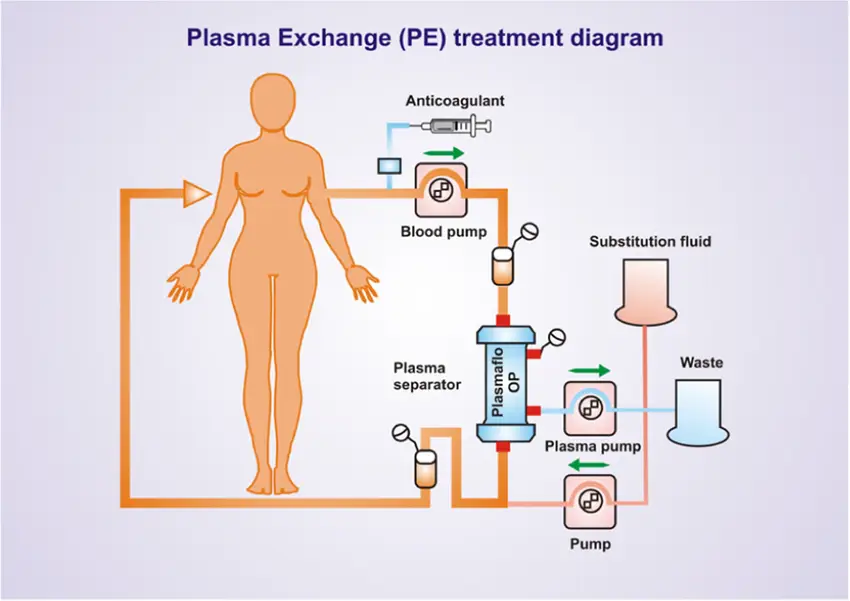Therapeutic Plasma Exchange
What is Therapeutic Plasma Exchange?
Therapeutic Plasma Exchange (TPE), also known as plasmapheresis or plasma exchange, is a medical procedure that involves the removal, treatment, and return of a patient’s plasma or liquid portion of blood. During TPE, blood is withdrawn from the patient’s body, separated by a machine to remove plasma, and then replaced with replacement fluid or plasma substitute before returning it to the patient’s circulation. The removed plasma contains harmful substances such as antibodies, immune complexes, toxins, or excessive proteins that contribute to various medical conditions. By removing and replacing the patient’s plasma, TPE aims to remove these harmful substances from the bloodstream and restore the balance of components in the blood.
What conditions require plasma exchange?
Therapeutic Plasma Exchange is employed in the management of autoimmune disorders, neurological disorders, certain types of cancer, and specific hematological or metabolic disorders where the removal of plasma components is beneficial. Conditions such as Guillain-Barré syndrome, myasthenia gravis, chronic inflammatory demyelinating polyneuropathy, thrombotic thrombocytopenic purpura, hemolytic uremic syndrome, certain types of neuropathy, multiple sclerosis, and certain types of leukemia may require plasma exchange as part of their treatment regimen.

How often do you need plasma exchange therapy?
The frequency of therapeutic plasma exchange or plasmapheresis varies depending on the specific medical condition being treated, the severity of the condition, and the individual patient’s response to treatment. In many cases, plasma exchange therapy is initially performed over a series of sessions close together, such as daily or every other day, to achieve the desired therapeutic effect. After this initial phase, the frequency of treatments may be gradually reduced based on the patient’s response and ongoing clinical assessment.
For some conditions, such as certain autoimmune disorders or neurological conditions, plasma exchange therapy may be performed intermittently as needed during disease flares or exacerbations to manage symptoms and improve outcomes. In other cases, such as certain hematological or metabolic disorders, plasma exchange therapy may be performed on a more regular schedule as part of ongoing disease management.
What are the benefits of Therapeutic Plasma Exchange?
Therapeutic Plasma Exchange offers several benefits for patients with various medical conditions:
- Removal of Harmful Substances: TPE effectively removes harmful substances from the bloodstream, such as antibodies, immune complexes, toxins, or excessive proteins, which contribute to the pathology of certain diseases. By eliminating these substances, TPE helps reduce disease activity and symptom severity.
- Management of Autoimmune Disorders: TPE is particularly beneficial in managing autoimmune disorders by removing autoantibodies and other immune-related factors that contribute to tissue damage and inflammation. Conditions such as Guillain-Barré syndrome, myasthenia gravis, and systemic lupus erythematosus (SLE) can be effectively managed with TPE.
- Treatment of Neurological Disorders: TPE is used to treat various neurological disorders, including chronic inflammatory demyelinating polyneuropathy (CIDP) and certain types of neuropathy. By removing antibodies or toxins that affect nerve function, TPE can help improve neurological symptoms and prevent disease progression.
- Hematological Disorders: TPE is employed in the treatment of hematological disorders such as thrombotic thrombocytopenic purpura (TTP) and hemolytic uremic syndrome (HUS). By removing factors that contribute to abnormal blood clotting or red blood cell destruction, TPE helps restore normal blood composition and function.
- Metabolic Disorders: Certain metabolic disorders, such as familial hypercholesterolemia and porphyria, can benefit from TPE by removing substances that accumulate abnormally in the blood or tissues. TPE helps alleviate symptoms and prevent complications associated with these disorders.
- Improved Transplant Outcomes: In transplant recipients, TPE can be used to prevent organ rejection by removing antibodies that target the transplanted organ. By reducing the risk of rejection, TPE improves transplant outcomes and increases the likelihood of long-term graft survival.
- Customized Treatment Approach: TPE treatments can be tailored to each patient’s specific needs and medical condition. This customization allows our team to optimize treatment outcomes while minimizing potential risks and side effects.
By withdrawing, treating, and returning the patient’s plasma, TPE effectively targets conditions such as autoimmune disorders, neurological disorders, certain cancers, and specific hematological or metabolic disorders where the removal of plasma components is beneficial. Conditions ranging from Guillain-Barré syndrome to thrombotic thrombocytopenic purpura may require plasma exchange as part of their treatment regimen. The frequency of TPE sessions varies depending on the condition and the patient’s response to treatment, with some conditions requiring intermittent sessions during disease flares while others necessitate more regular sessions for ongoing management. Overall, TPE offers a targeted therapeutic approach that helps alleviate symptoms, prevent complications, and improve patient outcomes across a spectrum of medical conditions.